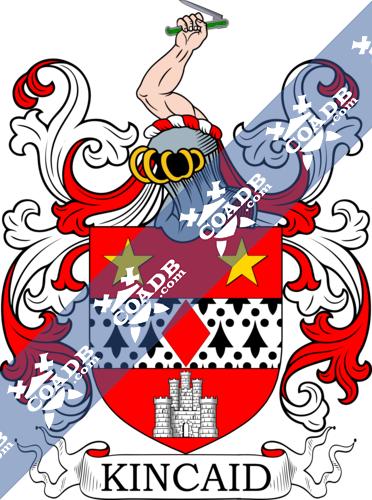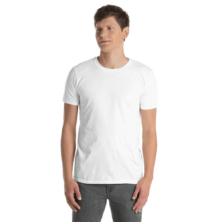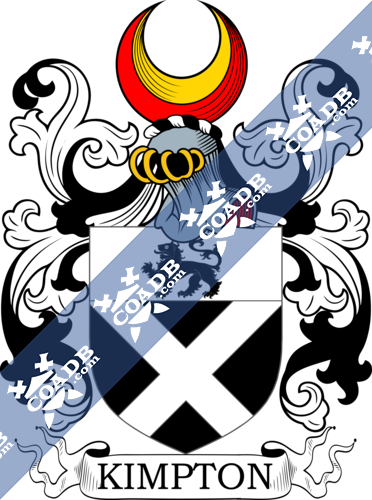Kincaid Family Crest, Coat of Arms and Name History

Kincaid Coat of Arms Gallery
Don’t know which Coat of Arms is yours?
We can do a genealogical research. Find out the exact history of your family!
Learn MoreKINCAID
Kincaid is a Clan of Scotland. It is thought the name is a direct translation of the Scots Gaelic word Ceanncadha, which mean ‘rocky or hard place.’ There is also two alternative meanings, one of which is ‘At the front of battle.’ and the second is ‘Head of the woods.’ With so many Scottish Clans, there is rarely one family which makes up the present Surname. Clans themselves usually made alliances with other families for protection and to increase their land holdings. If a smaller family married into a larger one, they would adopt the larger clans, surname as a hyphen on their own and or add a topographical name as a way of differentiating the senior line of the family and a cadet branch or junior side of the family, IE younger sons who might inherit due to war, death, and lack of heirs. One of the best examples of this system is to look to the families who were the ancestors of today’s Kincaid Clan; the Kincaid Clan is made up of several prominent Scottish families. Lennox being chief among them, followed by Comyn Lords of Badenoch, Galbraiths of Buthernock, and the Grahams.
The Kincaid surname was originally found in the lowlands of Scotland in and around Stirlingshire, north-west to Lanarkshire. This region during the 13th century was the primary battle grounds for the Scottish wars of independence from England. Because the clan has multiple origins, the earliest reference is to Maldouen 3rd Earl of Lennox receiving a grant of land in 1238, called ‘Kyncade’ from Scottish King Alexander II, in Lanarkshire. It is this land grant the clan takes their surname. Kincaid has at least ten historical different spellings of their surname. Such as Kincade, Kinkead and Kynayd. The differential spellings are due to phonetic spellings over the centuries, regardless they all are related to each other.
The next major reference to the Kincaid Clan is during the first Scottish war of independence in 1296 when a Francis Kincaid captured Edinburgh Castle, from an occupying English garrison. To herald this feat, the Clan coat of arms, was augmented with the addition of a crenelated castle/tower in their arms. The Laird or Lord of Kincaid was made the Constable of Edinburgh Castle, by Robert the Bruce. A position which carried a great deal of responsibility, as Edinburgh Castle was the home of Kings and Queens of Scotland. The Laird of Kincaid was charged with its defense and governance until 1314.
The 16th century was a time of growth for the future Clan. (The Kincaid family didn’t become a recognized clan until the 20th century.) With the addition of Castle Blackness, the family added Craiglock, and Banatskin Estates along with a large tract of land called the fields of Warriston. This rise in fortune also coincided with a rise in inter-clan conflict. Kincaids fought amongst their main family of Lennox several times, and had several bloody skirmishes with the Stirling family. All of whom had land which abutted each other. Several family members were slain. Because of their marrying into the Lennox family, this was in large part a family squabble which turned deadly. It is also an interesting point to note, because of their alliances through marriage Earls of Lennox, the Kincaid family in the 20th Century was able to establish themselves as an independent Clan.
The Kincaids were also one of the first families to mostly convert to Protestantism. During the 17th Century, they allied themselves with the interests of the English crown. They were also one of the larger families to immigrate to Irish plantations in Ulster, with large settlements in County Down in the the north-east, County Donegal in the north-west, Londonderry, Ulster in the north central part of Ireland, and in Tyrone the town of Omagh. During the rebellion of 1645, most Kincaid family members served not in Scotland, but rather helped to maintain order in Norther Ireland during the conflict. Because of their support for the English crown during this time, the Kincaids suffered greatly at the hands of their fellow Scotsmen. It was at this point the Kincaid surname began to immigrate to the Americas, and to the sugar plantations in Jamaica. (1655 Saw the Spanish defeated at Port Royal, which opened up a large segment of the Caribbean to English, later British colonists.)
In a complete reversal of roles a century earlier, the Kincaid family allied themselves with Charles Stuart, the heir and some would say the pretender to the Scottish throne. Kincaids fought at the battle of Culloden. With the disastrous results of the aftermath of Culloden several Kincaid family members immediately immigrated to the Crown Colony of Virginia.
Today the descendants of the Kincaid family can be found in the United States, Canada, Australia, New Zealand and South Africa. They have integrated, and smoothly assimilated into the countries and cultures they have moved to, without losing their unique sense of Scottish history and the part their ancestors have played in it. The current Chief of Clan Kincaid is Arabella Jane Kincaid of Kincaid. She is one of a number of female Chiefs and resides in the USA. Clan Kincaid’s Motto is “This I’ll Defend!”
Places associated with Clan Kincaid:
Kincaid House, Dunbartonshire, Lanarkshire, Stirlingshire, Edinburgh, Glasgow, Castle Blackness, Edinburgh Castle, Lennox Castle, Stirling Castle, Falkirk, and Culloden Scotland. Counties, Down, Donegal, Ulster, and Tyrone, and the towns of Portadown, Londonderry, and Omagh, Ireland. Richmond, Jamestown, Virginia. Ohio, Oklahoma, Oregon, Kansas, USA to name just a few. Montreal, Ontario, Ottawa, Vancouver BC, Canada. Sydney, Canberra, Perth, Brisbane, Australia. Auckland, Christchurch, Wellington New Zealand. Cape Town, Port Elizabeth, Pretoria, South Africa to name just a few places.
Blazons & Genealogy Notes
1) (that Ilk, co. Stirling). Motto—I’ll defend. Gu. a fess erm. betw. two mullets in chief or, and a castle triple-towered in base ar. masoned sa. Crest—A castle, as in the arms, and issuing therefrom a dexter arm embowed, grasping a sword ppr. Supporters—Two Highlanders armed with cuirasses, each grasping a Lochaber axe all ppr.
2) (Lord Provost of Edinburgh. 1776). Motto—I will defend. Gu.on a chev. ar. three stars of the field, in chief two spur-rowels or, and in base a castle of the second masoned sa. Crest—A dexter arm from the elbow holding a drawn sword ppr.
3) (Thomas Kincaid, surgeon, Edinburgh, 1685). Motto—lncidendo sano. Gu. on a fess erm. betw. two mullets in chief or, and a castle triple-towered in base, masoned sa. a lozenge of the first. Crest—A dexter hand holding a chirurgeon’s instrument, called bistoury, ppr.









